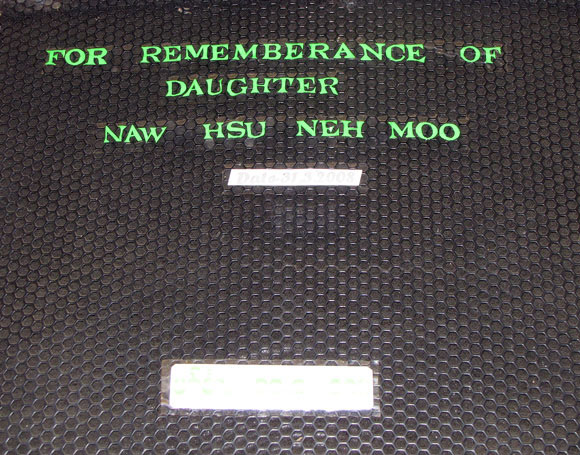
Fleeing grief: A mother worries, "We may not be able to regain the strength we had before."
By Julia Lyon | The Salt Lake Tribune
News of Hser Ner Moo’s murder raced across the ocean to Mae La, where thousands of families believed immigration to the U.S. would be their salvation.
Some said her death proved America’s dangers. Perhaps refugees were sent to bad neighborhoods, home to gangs. Others worried she was killed because she was Karen. Some families skipped resettlement interviews, one of the first steps in applying to emigrate to the U.S.
The U.S. embassy finally posted a letter explaining the man accused in Hser Ner Moo’s death was not an American. He was one of their own, a refugee from Mae La.
Rage flashed through the muddy lanes where Hser Ner Moo had once skipped rope and played hide-and-seek. In the camp, tension lingers between the Karen and Muslims, and some choose to live apart. Hser Ner Moo and Esar had lived in separate sections of Mae La.
America had made them neighbors.
Each Sunday at Mae La, Hser Ner Moo’s family had walked up a hill, across a bridge and past a blue tiled baptismal pool into their Karen Baptist church, where fans whirled beneath a tin roof. Cartoon and Hser Ner Moo would sometimes slip in the mud on the way as they walked hand in hand.
At her memorial at Mae La, mourners in the church’s wooden pews recited two lines from the Bible: “For how can I endure to see the evil that shall come unto my people? How can I endure to see the destruction of my kindred?”
The curry and rice the community shared after the service was paid for by Utah parents and grandparents. Imagining Pearlly and Cartoon’s pain, they had stopped by South Parc with envelopes of cash. The grieving parents didn’t want the money, and began sending it to the church in Thailand.
Some of the donations also paid for new larger speakers and a sound mixer. Now the hymns are sweeter, the pastor’s words more clear.
The church’s old speakers were sent away, traveling by car and boat before they were carried up a mountain in Burma, to another Baptist church that had never had a sound system before.
Hser Ner Moo amplified their prayers.
Honest answers » More than two years have passed since Hser Ner Moo and her family left Mae La. Her playmates are beginning to forget her.
Time has dulled 7-year-old Si Di’s memories, but then it all comes back, how she swung jump ropes with Hser Ner Moo, one of her best friends. How bad she had felt when her grandmother told her Hser Ner Moo had died.
The slim, wide-eyed girl shakes her head when asked if she would like to go to America, where her family may resettle.
“I’m afraid I could die, too,” she says.
Across the world in Phoenix, Ariz., Esar’s mother is bewildered by the murder case against her son. Is he going to be in jail forever? she wonders. Has he been sentenced?
Ra He Mar has visited him in jail twice. At first, Esar, who she says is 25, was very unhappy, but on the second visit he seemed more cheerful.
She told him that whatever the question, he should tell the truth. Esar agreed.
“And I will come back to you soon,” he told her.
She doesn’t want to believe her son killed Hser Ner Moo.
Utah is ‘our village’ » On a cold, windy morning in late October, a white rental van headed east from Salt Lake City filled with clothing, toys and the lamp signed by Hser Ner Moo. Where Cartoon went, Pearlly followed. She had given their furniture away to Eritrean refugees in Utah.
Pearlly arrived the next morning in Marshalltown at about 2 a.m. Cartoon ran right over to his toddler son.
The family unpacked slowly. After a few weeks, only one small photo of Hser Ner Moo sat on a ledge on Cartoon’s side of the bed. The frame has a pink furry trim.
Before work, Cartoon soaks his arms in warm water and gently stretches. The job at the pork plant makes his right arm ache. Sometimes the cold at work makes it hard to breathe. He wears three sweatshirts and two pairs of pants.
Pearlly notices her husband sleeps through the night. He seems more interested in playing with Eh Ler Wah, picking up after him when he scatters pumpkin seeds or pulls pots and pans out of a cabinet.
One day, they will tell him about Hser Ner Moo.
“His elder sister had a chance to actually carry him and hold him in her arms,” Cartoon says. “So he needs to know how his elder sister was murdered.”
Sunday, now 12, isn’t happy. His memories of Mae La are fading, and his mother is upset that he is forgetting how to read Karen. He misses his friends in Salt Lake City. And, he complains, the bedbugs in the Iowa apartment make it hard to sleep.
When Pearlly sits with Eh Ler Wah in the living room, she scratches the bites on her arms. Spread on the floor beneath them is a large red, white and blue quilt decorated with stars and stripes.
Their rent is lower, and Cartoon is making about $2 more per hour. They pray frequently. But, Pearlly worries, “We may not be able to regain the strength we had before.”
Moving to Iowa hasn’t eased their intense frustration about the murder case. They’re no longer surrounded by rumors -- like the gossip that Esar is out of jail. But they don’t know what has happened to him and worry there will be no justice for Hser Ner Moo.
Pearlly wonders if she has a lawyer. She wants to write to the court, but she isn’t sure how. They’ve never had an interpreter who was fluent in both Karen and English.
“What’s in our heart we cannot express,” Cartoon said. “We wish we could just talk in Karen.”
Since the murder, Pender, the Granite refugee liaison, has tried to keep them updated about developments in the case. Prosecutors say it could be weeks or even months before the case is resolved. Pender hasn’t heard anything from them since July.
Pearlly’s round, jovial face flattens when she talks about her grief. The mother especially misses her daughter at church because Hser Ner Moo loved to sing.
Once the prosecution is over, Pearlly and Cartoon want to return to Utah.
“It’s the first place where we landed in the United States, so basically you could call it our village, or our hometown,” Cartoon explains. “My home is in Utah. My daughter.”
They don’t plan to stay away from her grave forever.
Cartoon has asked an American friend, Christina Hayden, to take care of Hser Ner Moo. Hayden, a former teacher who helped search for the missing girl, never met her. But on Fridays, she visits Hser Ner Moo’s grave with her four children and talks to them about how to stay safe.
They sweep away the leaves, straighten the flowers and add new blooms.
Tribune reporter Julia Lyon traveled to Thailand this fall to visit refugee camps, including Mae La. She spoke to family and friends of Esar Met and Hser Ner Moo through interpreters while at the camp. Interpreters were also used to speak to both families in Utah, Arizona and Iowa. Though a large amount of interpretation was done in person, interpreters in Indiana, Seattle and New York City were also used via conference call in some interviews. Court records were also reviewed.
More about refugees in America :: Return to the table of contents










